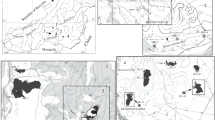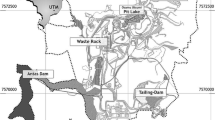Abstract
Traunsee is the deepest (189 m) lake in Austria and has been holomictic until the beginning of industrial discharges from the alkali works in Ebensee. The input of soluble compounds such as CaCl2 and NaCl have produced meromictic conditions. The relatively high oxygen content of the monimolimnion is due to water movements promoted by the large inflow and wind-action.
The industrial discharges have caused both meromictic conditions and the deposition of highly alkaline sediment in the southern portion of the profundal zone. The effect of the discharges on the benthic fauna was evaluated by comparing the subfossil benthic fauna of four cores taken inside and outside the affected area.
The ostracod fauna resembles that of other large lakes in the Salzkammergut, but also includes groundwater species such as Kovalevskiella and Cypridopsis subterranea. Leucocythere mirabilis has been found for the first time in an Austrian lake.
Ostracods and other benthic organisms such as Testacea were not apparently influenced by the meromictic condition. They are, however, missing in all areas covered by the alkaline sludge.
Similar content being viewed by others
References
Colin, J. P. & Danielopol, D. L., 1980. Sur la morphologie, la systematique, la biogeographie et l'evolution des ostracodes Timiriasevinae (Limnocytheridae). Paleobiol. Continent. 11, 1: 1–52.
Dobesch, H. & Neuwirth, F., 1980. Die Stabilitätsverhältnisse des Traunsees. Limnologische Untersuchung Traunsee — Traun. Oberrösterr. Landesreg. 1: 1–59.
Findenegg, I., 1959. Die Gewässer Osterreichs. Ein limnologischer Überblick. 14. Intern. Limnologenkongress 1959, Biologische Station Lunz, 1–68.
Graf. H., 1938. Beitrag zur Kenntnis der Muschelkrebse des Ostalpengebietes. Arch. Hydrobiol. 33: 401–502.
Löffler, H., 1963. Die Ostracodenfauna Österreichs. Sitz. Ber. Akad. Wiss., math.-nat. Kl. I, 172: 193–211.
Löffler, H., 1972. The distribution of subfossil ostracods and diatoms in pre-alpine lakes. Verh. Internat. Verein. Limnol. 18: 1039–1050.
Löffler, H., 1975. The Onset of Meromictic Conditions in Alpine Lakes. Quaternary Studies, Roy. Soc. New Zealand, 211–214.
Löffler, H., 1977. ‘Fossil’ meromixis in Kleinsee (Carinthia) indicated by ostracodes. In: H. Löffler & D. Danielopol (Eds.) Aspects of Ecology and zoogeography of recent and fossil Ostracoda, pp. 312–325, Junk, The Hague.
Löffler, H., 1978. The Paleolimnology of some Carinthian lakes with special reference to Wörthersee. Pol. Arch. Hydrobiol. 25: 227–232.
Löffler, H., 1979. Die Entwicklung des Jeserzer Sees (Saisser See). Carinthia II, 169./89: 367–370.
Ruttner, F., 1937. Limnologische Studien an einigen Seen der Ostalpen. (Seen des Saltzkammergutes, des Ötscher— und Hochschwabgebietes). Arch. Hydrobiol. 32: 167–319.
Schneider, J., 1980. Was serwirtschaftliche Planung Traunsee. Bericht über die bisherigen Arbeiten.
Stephanides, Th., 1948. A survey of the freshwater biology of Corfu and certain other regions of Greece. Praktika Helenic Hydrobiol. Inst. 2: 1–263.
Author information
Authors and Affiliations
Rights and permissions
About this article
Cite this article
Löffler, H. Changes of the benthic fauna of the profundal zone of Traunsee (Austria) due to salt mining activities. Hydrobiologia 103, 135–139 (1983). https://doi.org/10.1007/BF00028441
Issue Date:
DOI: https://doi.org/10.1007/BF00028441




